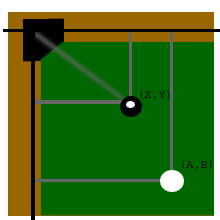|
|
|
Physics of Billiards:
Sinking the eight ball
| Physics (fiz'iks) n. The science that treats of matter and energy and the laws governing their reciprocal interplay under conditions susceptible to pre observation, experimental control, and exact measurement. |
A brief introduction to the billiards game.
| Billiards (bil'yerdz) n. A game played with hard elastic or ivory balls (billiard balls) propelled by cues on a oblong, cloth covered, cushion edged table. |
The origin of billiards is not certain to billiards archivists and historians but what most presume is it started in the late fourteenth or early fifteenth century as an outdoor lawn game. Before the table to version became popular billiard was played on grass outdoors with bigger balls. Players would push the ball with their hands to project the ball forward. Needless to say this put strain and required a lot more work, many grew tired of this and a new idea came about. The idea of using a stick to hit the ball rather than push it lessened the strain needed before to move the ball. According to the billiards historian William Hendricks the first game indoors took place in 1470. Following this event the popularity of the game increased and spread through Europe and America.
There are 4 different sizes of billiard tables; 3.5 x 7 ft, 4 x 8 ft, 4.5 x 9 ft, and 5 x 10 ft. Each table has six pockets, one located at each of the four corner and an addition pocket in the middle of the two longest sides. (picture) Corner pockets are usually 4.875-5.125 inches wide while the center pockets are usually 5.375-5.625 inches wide.
15 balls are used and one cue ball, the cue ball is used to hit the remaining balls in to the pockets. On average the balls are 2.25 inches in diameter and all balls weigh 5.5 oz except for the cue, which weighs 6 oz. For our experiment we will use one eight ball and the cue.
Example:
In our example we will set up one eight ball at position (x,y) on the pool table
and the cue at position (a,b)(Diagram 1). We want to demonstrate basic physic
concepts used to sink the eight ball into the corner pocket. Static friction
as well as air resistonce will be ingored. There are 3 basic concepts covered
in this example.
| Momentum | Inertia in motion. The product of the mass and the velocity of an object has magnitude and direction and therefore is a vector quantity. | = mass x velocity |
| Kinetic Energy | Energy of motion, equal to half the mass multiplied by the speed squared. | = 1/2 mass x velocity x velocity |
| Friction | Force that acts to resist teh relative motion of objects or materials that are in contact. |
Below (Diagram 1)
Given x = 12" and y = 12" the distance to the pocket for the eight ball is 16.97". So the eight ball must travel at least 16.97", although this nuber is not relivent becasue we will not be using numbers in this example it is used to give a better understanding of the distance to the hole. To make it possible for the eight ball to reach the hole the cue must carry a minimum amount of momentum. Although the friction coefficent is different in stationary objects in comparision to moving objects in this example we will think of friction as being constant.We know the weight of the eight ball so we can calculate the minimum amout of energy needed to place the ball in the pocket( we know the total distance to the hole). From there we can calculate how fast the cue ball needs to be traveling at the moment of impact. We know the distance the ball must travel and we know the mass of the ball and for example purposes we will say friction is applying a force on the ball in the oppisite dirrection slowing it down 4 inches per second. With this information we can calculate how much inerta is needed to roll the ball to the hole. Now that we know the minimum amout of inerta needed we can calculate how fast the cue needs to travel in order to have enough momentum to move the eight ball to the corner pocket, because we know the cue balls mass as well.
Theory:
Because energy can be neither created or destroyed the energy from the moving cue ball is transfered part to the stationary eight ball. The energy of the moving cue is kinetic, upon impact some of the enery is transformed into sound and heat, becasue the objects involved in the collision are both very solid the impact time is for only an instant the change in momentum is greater and the majority of the energy is transfered to the eight ball.